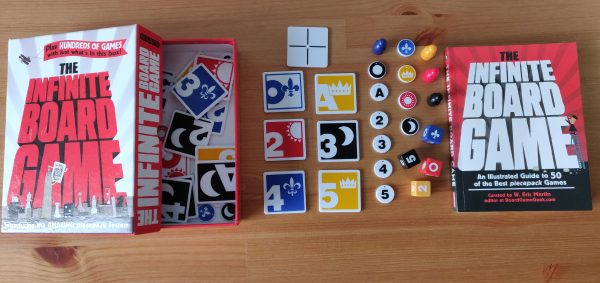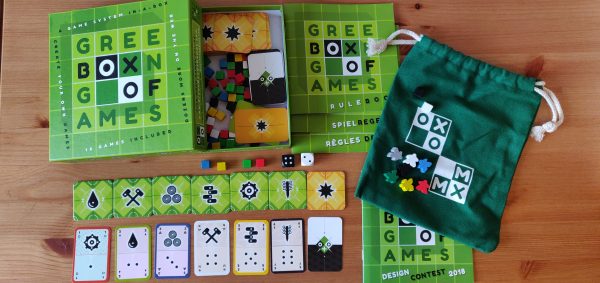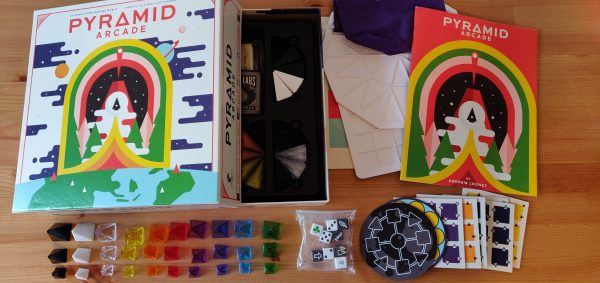I’ve played 105 different games in February this year. I didn’t buy or borrow 105 games, though. I only bought 3 game system with which I played all those games. And I could have played hundreds more.
A game system is not a single game but a set of items with which you can play multiple games. A deck of playing cards is a well-known example of a game system, or dominoes, or marbles. I love the versatility of playing cards, they are so small and can play hundreds (if not thousands) of games, so I was interested in others. A game system is also a great tool for game designers to help invent new games.
I bought 3 of the most popular game systems: a Piecepack, the Green Box of Games and Pyramid Arcade (with Looney Pyramids aka Icehouse Pieces) and tried them out.
This is my review of them. I looked at the quality of their components, the games you can play with them, their rulebooks and the design of each system.
Piecepack

A piecepack includes 24 tiles (6 ranks in 4 suits with the back divided into quarters), 24 coins (6 ranks in 4 suits with the rank on one and the suit on the other side), 4 pawns (1 per suit) and 4 dice (1 per suit with the 6 ranks).
There are a handful of commercial piecepacks available, and a lot more are self-made by individuals. Please note, comparing the quality of the components and the rulebook of this particular piecepack with the other game systems is a bit unfair because there is only one commercial version of the other game systems. The version I have is “The Infinite Board Game”.
- Games included: 50
- Overall available games: 223
- Year created: 2001
- License: Public Domain
- Piecepack on BoardGameGeek
- Piecepack website
- Wiki with all Piecepack games
Quality of components
The pieces are of quite a high quality. Most other “commercial” piecepacks can be quite unappealing. This one is of a hard plastic that feels and sounds great. I love the clickety clack of the tiles when putting them down on the table. Unfortunately they are also a dirt and especially cat hair magnet and scratch easily. The pawns and dice are not colourblind-friendly, especially the pawns could have a symbol added to them. The tiles are not made according to spec, which is inconsequential for most games but more important for at least one that I’m aware of. And the nulls are designed in a way which can very easily be confused with the moon suit.
All of this does not necessarily apply to other piecepacks.
Games
Most games of the 50 in the book are quite boring. And some of them don’t even work. Because there are over 200 games for a piecepack, I had hoped that these would be a selection of the best. I guess either the selection is not the most interesting or most games are indeed boring.
Interestingly, about a third of the games in the book are solitaire games.
I always find it interesting when people manage to port existing games to a game system. Some games ported to a piecepack are Checkers, Lines of Action or Settlers of Catan.
My favourite games are Relativity, Skyscrapers and Cardinal’s Guards.
Rulebook
I’ve read and watched a couple of reviews before I bought this piecepack. And all of them agree that the rulebook is the best thing about this version and that it’s very well written.
I couldn’t disagree more.
The instructions are sometimes so difficult to understand that I couldn’t play the game without googling another version of the rules. They are quite inconsistent, are missing information and sometimes say the wrong things. For example, they sometimes say “green” when they mean “yellow”. Or they tell you each symbol stands for a resource and then never mention what those resources are. Or they show a picture with 7 coins per suit while there are only 6. Or they show a picture which has nothing to do with the corresponding game. Or they confuse “number-side up” and “suit-side up”. Or they refer to colours in an illustration which are not present in that illustration. Or they use terms they never explain or explain way too late so you have to read the instructions again to understand the beginning.
The book looks great and consistent and has nice illustrations. But the content should have been tested with people who have never played those games and it should have been edited properly.
None of this applies to other piecepacks. I suspect most others would simply point to piecepack.org for any rules. The problem with that is that the website is quite unappealing and looks like it has been designed 20 years ago. That makes many people assume the project is dead. It’s also difficult to find information on there. Because the games were designed by lots of different people, the way the rules were written is quite inconsistent. And for some odd reason, the majority of the rules are only available in PDF files.
Design of the system
I love the general concept. The different components make sense and work well together, although not necessarily their amount. I get that you have to have a limited amount of pieces to keep it portable. But it often feels like 6 pieces are not enough. Some games would definitely work better with more pieces.
When you have to group two suits (for example, one player uses suns and moons and the other arms and crowns), it’s difficult to make that connection between them. Some piecepacks fix that by giving two suits a dark background and the other two suits a light background.
A lot of piecepacks don’t follow the original specs. One flaw that some of them try to fix is that the ace rank is supposed to be depicted as the suit symbol. That is why it changes (inconsistently but understandably) into a spiral symbol when used on the coins, as the suit needs to be hidden on the number side. Just using the spiral everywhere or a simple well-known “A” would make that more consistent. And some piecepacks do just that, like this one does.
The back of the tiles are designed in a way that you can form various boards with them. That is really great. Although at least for some games it would be better if the backs were chequered. With 24 tiles and every back divided into quarters, that’s a maximum of a 10×10 board with a hole in the middle, or 8×12, for example.
Rating
- Quality of components:
- Games:
- Rulebook:
- Design of the system:
- Overall:
Green Box of Games (GBOG)

The Green Box of Games includes 36 tiles (6 times 6 symbols with a back divided into quarters), 54 cards (a 3-dimensional combination of a border with 1 of 6 colours, a number 1-6, 1 of 6 symbols; it shows the symbol on one half and a die face on the other, the back is half white and half black), 80 cubes (20 per 4 colours), 2 dice. The “MMX expansion” includes: 7 meeples (in 7 different colours) and 40 extra cubes (20 per 2 more colours).
- Games included: 33 (including the MMX expansion)
- Overall available games: 70
- Year created: 2016
- License: CC BY-NC-SA
- Green Box of Games on BoardGameGeek
- Green Box of Games website
- Wiki with all GBOG games
Quality of components
The tiles are great, they feel and sound good. The cards are a bit low quality and they are difficult to pick up. They wear and tear pretty easily and after only a couple of games. The cubes are okay, quite small and light and a bit lo-fi compared to the other components but they get the job done.
The cubes and the border of the cards are not colourblind-friendly.
Games
The best games make use of the different dimensions of the cards, which can lead to interesting interactions. The games are a mix of interesting and boring with a diverse mix of categories.
It’s a pity that there are not that many games yet, but that’s only because this system is just a bit over two years old.
Some games ported to the GBOG are Backgammon, Port Royal and Carcassonne.
My favourite games are The Gauntlet, Othellino and King’s Valley.
Rulebook
The rulebook is generally well written with some exceptions, especially when games were designed by other people. A couple of things are unclear and made me play a game wrongly at first.
Although some games refer to the symbols as numbers, those numbers are never explained anywhere. I figured it out by myself after a while that every symbol has a different amount of white dots which represents that number.
There is a scoring board at the back which can be helpful for some games.
Design of the System
The cards are the best and the worst part of the system. The combination of symbols, numbers, border colours and background colours is very versatile. And that alone means you can do more interesting and diverse things than with a piecepack.
It’s annoying that the cards are divided into two halves, one half with a symbol and the other with a die face. Especially as the die face shows the very same number than the upper half and it is not used in a single game (not even GBOG’s version of Liar’s Dice). Not sure if it’s just me but I keep on turning cards around all the time when they are “the wrong side”.
The cards also have three different background colours. Although that is not used in any game, it is sometimes used as a means to “filter” the cards into different decks. Having that mechanism is quite helpful. But it’s not sufficient as it’s so subtle, difficult to see and they use confusing names for the colours.
The symbols themselves are very versatile. It is not explained anywhere what the symbols are called. I suspect that is intentional, though. They are vague enough but at the same time not too abstract. I would describe them as: drop, hammers, circles, bricks, cog and mast. But depending on the game, they could be interpreted very differently. Although that can be confusing, I think that is a good thing overall.
Like with a piecepack you can form various boards with the back of the tiles. By just using each tile as one space, you can form a 6×6 board. Or if you use the 4 quarters of a tile, that’s a maximum of a 12×12 board. As the potential for bigger boards give you more options, that’s even better than a piecepack.
Last but not least, the name of the system is probably not helpful. Surely the fact that the tiles and the box are green should not have anything to do with the system itself? And “box of games” is too generic. Such a generic name might hinder its popularity as it might make it difficult to remember the name or google and find it. (Googling the exact name finds it, but what if someone just remembers there is a container with game pieces and it referred to some colour.)
Rating
- Quality of components:
- Games:
- Rulebook:
- Design of the system:
- Overall:
Pyramid Arcade / Looney Pyramids / Icehouse Pieces

Pyramid Arcade includes 90 plastic pyramids (3 small, 3 medium, 3 large per 10 colours), 11 different boards, 9 different dice and various cards…
- Games included: 22
- Overall available games: 446
- Year created: 1989
- License: Copyright
- Pyramid Arcade on BoardGameGeek
- Pyramid Arcade website
- Wiki with all Looney Pyramid games
Quality of components
The pyramids feel and look amazing. It is a joy to make trees and nests out of them. All the other pieces in the box are also of a high quality except the playing cards (Zark City cards) which are rarely used anyway. Especially putting the plastic pyramids into a fitting notch on a plastic board feels very satisfying.
The pyramid themselves are not colourblind-friendly. Although the instructions mention that at least due to the huge amount of available colours (10), colourblind people can choose colours that are most distinct to them.
Games
Pyramid games are mostly very different than a lot of other games. They are definitely a different category than piecepack and GBOG games. Most games are interesting at least because of that.
Because the pyramids are so different and games for the system quite original, there are hardly any games ported to this system.
My favourite games are Volcano, Highjinks and Looney Ludo.
Rulebook
The rulebook is mostly great with a few exceptions where clarifications are needed. A few more explanatory graphics would have been good as well. I ended up making diagrams on a piece of paper to aid me understand and remember things. In addition to the rules you can also watch cute videos of the makers playing all the games on YouTube.
The book has gorgeous, clear graphics and a good layout. It also includes more information about the history of the pyramids. It would have been better if the A4 rulebook was smaller and therefore more portable.
Design of the System
The question is if “the system” only includes the pyramids or everything else as well. That’s not as clear as with the other systems. I will consider only the pyramids as you can purchase them separately and could play most games with a chessboard. But I would rate the system a bit lower if it included all the boards, just because it contains too many unrelated pieces.
The simple combination of colour and size is surprisingly versatile.
Although the pyramids have only two dimensions like playing cards (you could interpret the 3 sizes as suits and the 10 colours as ranks, or vice versa), it plays very differently. I suspect that is because you cannot easily hide your “cards” and that the possibility to stack or nest them adds a different dimension to the gameplay.
Most of the boards seem a bit pointless because they are only used for one game. It would fit the pyramids better if the box had a “board system” similar to the other two game systems. For the pyramids I can imagine maybe interlocking plastic pieces to build most boards? Looney Labs did something in that direction with the “Deluxe MegaVolcano Board” and the “ELBS”. ELBS are “eleven little black squares” that fit into the Volcano board and can fill hollow squares to make the playing area smaller.
Rating
- Quality of components:
- Games:
- Rulebook:
- Design of the system:
- Overall: